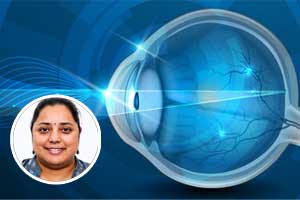- Home
- Editorial
- News
- Practice Guidelines
- Anesthesiology Guidelines
- Cancer Guidelines
- Cardiac Sciences Guidelines
- Critical Care Guidelines
- Dentistry Guidelines
- Dermatology Guidelines
- Diabetes and Endo Guidelines
- Diagnostics Guidelines
- ENT Guidelines
- Featured Practice Guidelines
- Gastroenterology Guidelines
- Geriatrics Guidelines
- Medicine Guidelines
- Nephrology Guidelines
- Neurosciences Guidelines
- Obs and Gynae Guidelines
- Ophthalmology Guidelines
- Orthopaedics Guidelines
- Paediatrics Guidelines
- Psychiatry Guidelines
- Pulmonology Guidelines
- Radiology Guidelines
- Surgery Guidelines
- Urology Guidelines
Simple test to prevent childhood blindness due to retinopathy of prematurity

A simple tear based testing of inflammatory proteins can help in screening the premature babies who are at risk of developing a blinding condition - retinopathy of prematurity.
Premature birth interrupts developmental processes, leading to severe complications post birth. Retinopathy of Prematurity (ROP) is one of the most common serious ocular complications associated with preterm birth leading to incomplete blood vessel growth in the retina. About 40- 50% of prematurely born infants develop this condition and of this 10-18% progress to develop severe stages of this disease leading to blindness in these babies. Increased and unmonitored oxygen levels in the eye when the babies are kept in incubator and low oxygen levels particularly in the retina when the child is out of incubator were thought to cause abnormal blood vessel growth in the retina leading to the loss of neurons and thereby vision loss in the preterm infants. However, some of the premature infants despite properly monitored oxygen supplementation and adequate and similar prenatal and antenatal care, develop severe ROP that further increase the risks of retinal detachment and vision loss. Several risk factors for ROP such as low gestational age, low birth weight, oxygen supplementation, sepsis, multiple births and maternal health during pregnancy were thought to help in predicting the risk of ROP progression in these prematurely born infants, but even those could not help in predicting the risk of severe ROP. An early method of diagnosing this condition can help the clinicians to monitor the blood vessel growth and give timely treatment to these babies to prevent the severe stages of ROP. At the LV Prasad Eye Institute, we have initiated a research to identify some genetic or protein-based marker (biomarkers) that can help to develop a simple and reliable test to predict the risk of getting this condition and diagnosing it at an earlier stage for an efficient treatment and outcome thereby preventing the visual loss in the babies born prematurely.
“A biomarker test can aid in identifying the preterm infants who are at risk of developing severe ROP (much before developing the typical features of severe ROP in the eye) and visual loss, if not treated on time,” said Dr Inderjeet Kaur, Scientist, L V Prasad Eye Institute, Hyderabad to Speciality Medical Dialogues.“Based on the information generated from our study, we are working with the engineers at the Indian Institute of Technology, Hyderabad to develop a device to measure the inflammatory marker from tears. Once developed, this user-friendly device could be used for screening even by the paramedical staff or health workers,” she added.
Our research finding identified few proteins that cause the inflammation in the eye leading to abnormal blood vessel growth. The levels of these inflammatory proteins namely Complement component C3 and Matrix metalloproteinases 2 &9 were found to increase substantially in the tear samples of the eyes of preterm babies who develop severe ROP.
According to Dr.Kaur “The cost of the test is not available at the moment but it is convenient for routine screening and can be used even by paramedical staff or health care workers.”
These findings were published in an international Journal - Frontiers in Immunology very recently and paved the way to develop a test that can predict the risk of severe ROP and be monitoring the response to the treatment. The study explained the role of inflammation caused by reduced oxygen levels in the eyes in the development of this condition. This research was presented at several international and national meetings and hailed as one of the significant research to prevent childhood blindness due to ROP. LV Prasad Eye Institute has been engaged in conducting a major twin city based ROP screening program for ROP at all the major NICUs for several years and this model of ROP has been accepted by the state governments (AP and Telangana) for the entire state wise screening and in National health screening program. This new finding would help to strengthen the existing ROP screening program.
Author Dr. Inderjeet Kaur is a Scientist at L V Prasad Eye Institute, Hyderabad.

Disclaimer: This site is primarily intended for healthcare professionals. Any content/information on this website does not replace the advice of medical and/or health professionals and should not be construed as medical/diagnostic advice/endorsement or prescription. Use of this site is subject to our terms of use, privacy policy, advertisement policy. © 2020 Minerva Medical Treatment Pvt Ltd